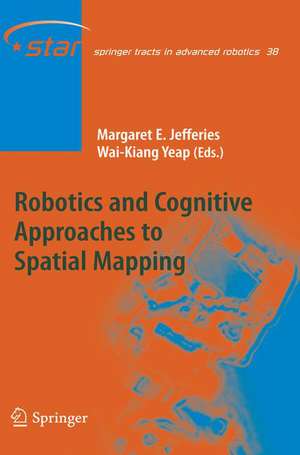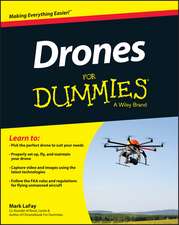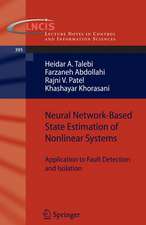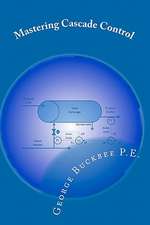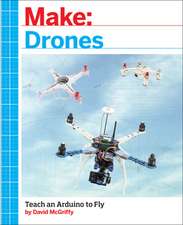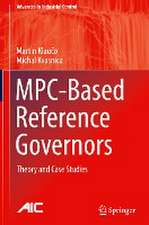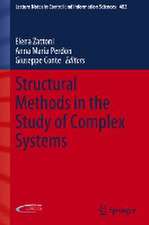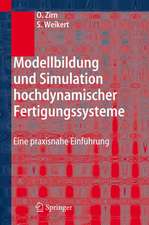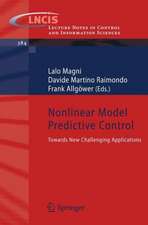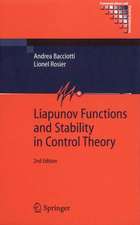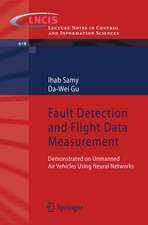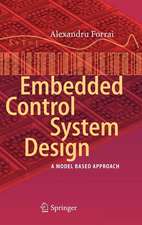Robotics and Cognitive Approaches to Spatial Mapping: Springer Tracts in Advanced Robotics, cartea 38
Editat de Margaret E. Jefferies, Wai-Kiang Yeapen Limba Engleză Hardback – 10 ian 2008
| Toate formatele și edițiile | Preț | Express |
|---|---|---|
| Paperback (1) | 946.87 lei 43-57 zile | |
| Springer Berlin, Heidelberg – 22 oct 2010 | 946.87 lei 43-57 zile | |
| Hardback (1) | 951.29 lei 43-57 zile | |
| Springer Berlin, Heidelberg – 10 ian 2008 | 951.29 lei 43-57 zile |
Din seria Springer Tracts in Advanced Robotics
- 18%
 Preț: 910.26 lei
Preț: 910.26 lei - 18%
 Preț: 893.71 lei
Preț: 893.71 lei -
 Preț: 445.98 lei
Preț: 445.98 lei -
 Preț: 406.43 lei
Preț: 406.43 lei -
 Preț: 523.44 lei
Preț: 523.44 lei - 17%
 Preț: 378.35 lei
Preț: 378.35 lei - 15%
 Preț: 640.88 lei
Preț: 640.88 lei - 18%
 Preț: 783.98 lei
Preț: 783.98 lei - 15%
 Preț: 641.74 lei
Preț: 641.74 lei - 15%
 Preț: 640.88 lei
Preț: 640.88 lei - 18%
 Preț: 994.72 lei
Preț: 994.72 lei - 18%
 Preț: 778.45 lei
Preț: 778.45 lei - 18%
 Preț: 730.35 lei
Preț: 730.35 lei - 18%
 Preț: 1233.83 lei
Preț: 1233.83 lei - 18%
 Preț: 951.47 lei
Preț: 951.47 lei - 15%
 Preț: 640.06 lei
Preț: 640.06 lei - 18%
 Preț: 1844.67 lei
Preț: 1844.67 lei - 15%
 Preț: 642.51 lei
Preț: 642.51 lei - 18%
 Preț: 1112.30 lei
Preț: 1112.30 lei - 15%
 Preț: 665.08 lei
Preț: 665.08 lei - 18%
 Preț: 947.85 lei
Preț: 947.85 lei - 15%
 Preț: 640.88 lei
Preț: 640.88 lei - 18%
 Preț: 776.88 lei
Preț: 776.88 lei - 18%
 Preț: 959.04 lei
Preț: 959.04 lei - 15%
 Preț: 659.02 lei
Preț: 659.02 lei - 15%
 Preț: 654.95 lei
Preț: 654.95 lei - 18%
 Preț: 973.38 lei
Preț: 973.38 lei - 5%
 Preț: 724.70 lei
Preț: 724.70 lei - 18%
 Preț: 981.49 lei
Preț: 981.49 lei - 18%
 Preț: 954.45 lei
Preț: 954.45 lei - 15%
 Preț: 641.53 lei
Preț: 641.53 lei - 15%
 Preț: 653.98 lei
Preț: 653.98 lei - 24%
 Preț: 814.81 lei
Preț: 814.81 lei - 18%
 Preț: 968.65 lei
Preț: 968.65 lei - 18%
 Preț: 970.70 lei
Preț: 970.70 lei
Preț: 951.29 lei
Preț vechi: 1160.10 lei
-18% Nou
Puncte Express: 1427
Preț estimativ în valută:
182.05€ • 188.91$ • 152.16£
182.05€ • 188.91$ • 152.16£
Carte tipărită la comandă
Livrare economică 17-31 martie
Preluare comenzi: 021 569.72.76
Specificații
ISBN-13: 9783540753865
ISBN-10: 3540753869
Pagini: 350
Ilustrații: XIV, 330 p.
Dimensiuni: 155 x 235 x 19 mm
Greutate: 0.61 kg
Ediția:2008
Editura: Springer Berlin, Heidelberg
Colecția Springer
Seria Springer Tracts in Advanced Robotics
Locul publicării:Berlin, Heidelberg, Germany
ISBN-10: 3540753869
Pagini: 350
Ilustrații: XIV, 330 p.
Dimensiuni: 155 x 235 x 19 mm
Greutate: 0.61 kg
Ediția:2008
Editura: Springer Berlin, Heidelberg
Colecția Springer
Seria Springer Tracts in Advanced Robotics
Locul publicării:Berlin, Heidelberg, Germany
Public țintă
ResearchCuprins
Robot and Cognitive Approaches to Spatial Mapping.- Robot and Cognitive Approaches to Spatial Mapping.- I: Robot Mapping.- Robot Mapping: An Introduction.- Simultaneous Localization and Mapping.- Hybrid, Metric-Topological Representation for Localization and Mapping.- Machine Perception in Unstructured and Unknown Environments.- Emergent Cognitive Mappings in Mobile Robots Through Self-organisation.- Towards a Generalization of Self-localization.- II: Cognitive Mapping.- Dead Reckoning, Cognitive Maps, Animal Navigation and the Representation of Space: An Introduction.- Geometry and Navigation.- Cue and Goal Encoding in Rodents: A Source of Inspiration for Robotics?.- These Maps Are Made for Walking – Task Hierarchy of Spatial Cognition.- Landmarks for Navigation in Human and Robots.- Learning Cognitive Maps: Finding Useful Structure in an Uncertain World.- III: Cognitive Robot Mapping.- Cognitive Robot Mapping: An Introduction.- An Intellectual History of the Spatial Semantic Hierarchy.- Robot Cognitive Mapping – A Role for a Global Metric Map in a Cognitive Mapping Process.- Using a Mobile Robot to Test a Theory of Cognitive Mapping.- A Robot System for Biomimetic Navigation – From Snapshots to Metric Embeddings of View Graphs.- Robots as Tools for Modelling Navigation Skills – A Neural Cognitive Map Approach.
Textul de pe ultima copertă
This book brings together the fields of robot spatial mapping and cognitive spatial mapping, which share some common core problems. One would reasonably expect some cross-fertilisations of research between the two areas to have occurred, and this has happened but only recently. There are signs that both fields have matured and that efforts to cross-fertilise are happening, but it is neither complete nor common yet.
Robot spatial mapping, in this book, is about the problem of a robot computing a representation of its environment from data gathered by its sensors. This problem has been studied since the creation of the first autonomous mobile robot in the late nineteen-sixties. People and animals also compute a representation of their environment, which is commonly referred to as a cognitive map. Cognitive spatial mapping is about the problem of computing a cognitive map, and has been studied extensively by many researchers of disparate backgrounds.
The book consists of three parts: Robot Mapping, Cognitive Mapping, and Cognitive Robot Mapping. The first part addresses a cross section of problems commonly found in robot mapping, such as uncertainty, localization, unstructured environments, and control architectures. It includes a comprehensive introduction to the famous SLAM problem. Part two presents works on cognitive mapping and discusses how the findings could benefit researchers interested in robot mapping. Spatial cognition is examined based on behaviour of humans and animals, and how spatial information is encoded in the brain. The third part presents implementations of cognitive mapping theories on mobile robots. It includes computational models of cognitive maps, such as hybrid metric-topological ones, absolute space representations, and biomimetic approaches.
Robot spatial mapping, in this book, is about the problem of a robot computing a representation of its environment from data gathered by its sensors. This problem has been studied since the creation of the first autonomous mobile robot in the late nineteen-sixties. People and animals also compute a representation of their environment, which is commonly referred to as a cognitive map. Cognitive spatial mapping is about the problem of computing a cognitive map, and has been studied extensively by many researchers of disparate backgrounds.
The book consists of three parts: Robot Mapping, Cognitive Mapping, and Cognitive Robot Mapping. The first part addresses a cross section of problems commonly found in robot mapping, such as uncertainty, localization, unstructured environments, and control architectures. It includes a comprehensive introduction to the famous SLAM problem. Part two presents works on cognitive mapping and discusses how the findings could benefit researchers interested in robot mapping. Spatial cognition is examined based on behaviour of humans and animals, and how spatial information is encoded in the brain. The third part presents implementations of cognitive mapping theories on mobile robots. It includes computational models of cognitive maps, such as hybrid metric-topological ones, absolute space representations, and biomimetic approaches.
Caracteristici
Leading research in the field of cognitive mapping and robot mapping Brings together robotics and cognition
